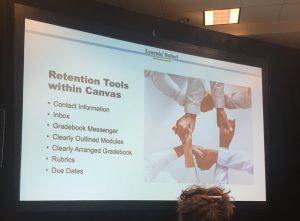The decision to continue one’s pursuit of higher education is influenced by a multitude of factors in the personal and academic realms. It comes of no surprise that the role of faculty plays a primary part in shaping the degree to which students feel connected, or integrated, to academic life at their institution of choice. At Geneseo, where the retention of Knights between their first and second years is a Wildly Important Goal, our faculty hear often about the importance of regular, timely, and graded feedback. This post is, to some extent, an exception.
Retention was a topic of discussion at InstCon 2019, the annual Canvas conference. Several universities tackled the question of “What tools do we have at our disposal to aid in retention?“. Admitting that Canvas itself is a phenomenal retention tool, several specific features were identified:

- Contact information
- Inbox (learn more about leveraging Canvas messages as an alternative to email)
- Gradebook (learn more about the recently-released New Gradebook, including automated options and the ability to “message students who”)
- Clearly outlined modules
- Clearly arranged gradebook
- Rubrics
- Due dates
Each item in the list above makes an appearance, either directly or indirectly, in the minimum course design requirements and proven practices for course design at Geneseo. Often times, a small change in how we use Canvas can have a big impact on student success and the retention of learners. Consider watching the “Attention = Retention” presentation (31 minutes); this small effort, especially when combined with a one-on-one appointment with an Instructional Designer and resident Canvas expert, offers great potential for increasing the likelihood of learner success in your course(s).
